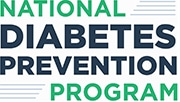The National DPP → National DPP Overview
National Diabetes Prevention Program Overview
Research has shown that investing in type 2 diabetes prevention can slow or prevent the development of type 2 diabetes in adults with prediabetes or who are at risk for developing type 2 diabetes—resulting in reduced costs and healthier populations. As defined by the Centers for Disease Control and Prevention (CDC), “a person with prediabetes has a blood sugar level higher than normal, but not high enough for a diagnosis of diabetes. He or she is at higher risk for developing type 2 diabetes and other serious health problems, including heart disease and stroke.”
To address this problem, CDC established the National Diabetes Prevention Program (National DPP), which is a partnership of public and private organizations that provide the framework for type 2 diabetes prevention efforts in the U.S. One component of the National DPP is the National DPP lifestyle change program. This program is founded on the science of the Diabetes Prevention Program research study and several translation studies that followed.
To learn more, the CDC website provides comprehensive information and resources on the National Diabetes Prevention Program.
The CDC recently launched a new Customer Service Center to provide organizations easy access to information and resources about prediabetes and the National DPP. Organizations can access training materials, toolkits, and videos; ask questions; and receive technical assistance related to all aspects of the program.
Prevalence of Prediabetes
An estimated 96 million US adults—greater than 1 in 3 adults in the US—have prediabetes. With prediabetes, blood sugar is higher than normal but not high enough yet to be diagnosed as diabetes. People with prediabetes are at high risk for type 2 diabetes (the most common type of diabetes), heart disease, and stroke.
For more information, or statistics on the prevalence of diabetes and prediabetes in your state, see: CDC’s Interactive Diabetes Data and Statistics, the Diabetes State Burden Toolkit, the 2022 National Diabetes Statistics Report, and the American Diabetes Association Statistics by State Fact Sheets.
The National Diabetes Prevention Program (National DPP)
To better address the growing problems of prediabetes and type 2 diabetes, Congress authorized the CDC to establish the National DPP, a public-private initiative that provides the framework for type 2 diabetes prevention efforts in the United States.
Key partners include:
- Federal agencies
- State and local health departments
- National and community organizations
- Employers
- Public and private insurers
- State employee health programs
- Health care professionals
- University community education programs
- Businesses that focus on wellness
CDC’s Diabetes Prevention Recognition Program (DPRP)
To ensure high quality and impact, CDC sets standards for organizations that wish to offer a lifestyle change program. CDC’s DPRP plays a critical role in assuring that organizations can effectively deliver the evidence-based lifestyle change program with quality and fidelity. To achieve CDC recognition, organizations must provide evidence that they are following a CDC-approved curriculum and achieving meaningful results with patients based on established national standards.
For more information, see the Standards for CDC Recognition.
CDC-Recognized Organizations
The National DPP lifestyle change program is offered through CDC-recognized organizations. These are organizations that have received full, pending, or preliminary recognition from the CDC’s DPRP. CDC-recognized organizations can deliver the program in person, online, through distance learning (e.g., remote classroom or telehealth), or through a combination approach.
CDC-recognized organizations are comprised of a variety of different organization types, including community-based organizations, hospitals, provider groups, pharmacies, health plans, and other organizations. A registry of recognized organizations is provided here. For a map of the United States showing publicly available in-person National DPP lifestyle change program class locations, click here.
The CDC developed the Find a Program tool and the Find a Program fact sheets as resources for program participants and CDC-recognized organizations. The Find a Program tool provides new and returning National DPP participants an on-demand list of available lifestyle change programs offered in a specified area. The Find a Program fact sheet for CDC-recognized organizations provides information to navigate the DPRP Data Submission Portal to update their organization’s public class information.
The National DPP Lifestyle Change Program
The National DPP lifestyle change program is an evidence-based program focused on helping participants make positive lifestyle changes such as eating healthier, reducing stress, and getting more physical activity.
Research shows that people with prediabetes who take part in this structured lifestyle change program can cut their risk of developing type 2 diabetes by 58% (71% for people over 60 years old). This is the result of the program helping people lose 5% to 7% of their body weight through healthier eating and 150 minutes of physical activity a week. For a person who weighs 200 pounds, 5% to 7% of their body weight is equivalent to 10 to 14 pounds.
- It is a year-long program that is delivered in person, online, or through a combination approach. The program includes at least 16 weekly sessions during the first 6 months and at least 6 monthly sessions during the second 6 months.
- The program is taught by trained Lifestyle Coaches. Coaches can be health professionals or non-licensed personnel.
- The program includes group support (recommended group size ranges between 10 and 25 participants, online groups may be larger).
- CDC-recognized organizations offering the program can use a curriculum developed by CDC, can develop their own curriculum and submit it to CDC for approval, or can receive permission to use another organization’s curriculum as long as it is CDC approved.
- The newly developed CDC curriculum (PreventT2) is available in both English and Spanish. The Spanish version is culturally adapted. You can also find translated curriculum here.
- There are thousands of CDC-recognized organizations across the 50 states and D.C. To find a program near you, click here.
For more information, see the CDC’s National Diabetes Prevention Program and Research-Based Prevention Program.
Eligible Population
The National DPP lifestyle change program is designed for people 18 years or older who have prediabetes or who are at risk for type 2 diabetes, but who do not already have type 2 diabetes. To be eligible for referral to the National DPP lifestyle change program, individuals must meet the following requirements:
- All of a program’s participants must be 18 years of age or older. The program is intended for adults at high risk of developing type 2 diabetes.
- All of a program’s participants must have a body mass index (BMI) of ≥25 kg/m2 (≥23 kg/m2, if Asian American).
- All of a program’s participants must be considered eligible based on either:
- A blood test result within one year of participant enrollment. Blood test results may be self-reported for CDC recognition purposes. Participants enrolled in the Medicare Diabetes Prevention Program (MDPP) cannot self-report blood test results; lab results must be provided. Blood test results must meet one of the following specifications:
- Fasting glucose of 100 to 125 mg/dl (Centers for Medicare and Medicaid Services-CMS- eligibility requirement for MDPP participants is 110 to 125 mg/dl);
- Plasma glucose of 140 to 199 mg/dl measured 2 hours after a 75 gm glucose load;
- HbA1C of 5.7 to 6.4; or,
- Clinically diagnosed gestational diabetes mellitus (GDM) during a previous pregnancy (allowed for CDC recognition and may be self-reported; not allowed for MDPP participants); or
- A positive screening for prediabetes based on the Prediabetes Risk Test online. Note: The risk test is not an option for eligibility for MDPP participants.
- Participants cannot have a previous diagnosis of type 1 or type 2 diabetes prior to enrollment.
- Participants cannot be pregnant at time of enrollment.
- A health care professional may refer potential participants to the program, but a referral is not required for participation in a CDC-recognized program.
To be eligible for the National DPP lifestyle change program, individuals must have one of the blood test results described above, be previously diagnosed with gestational diabetes, or score positive for prediabetes on the CDC/ADA Prediabetes Risk Test. The CDC Diabetes Prevention Recognition Program (DPRP) standards require that at least 35% of a program’s participants be diagnosed with prediabetes through blood testing (or have a history of gestational diabetes). The remaining participants in the group can be considered eligible for the program based on their scores on the CDC/ADA Prediabetes Risk Test. The CDC/ADA Prediabetes Risk Test is a brief seven question survey that allows one to gauge their risk of having prediabetes. Regularly scheduled biometric screenings may be an opportunity to determine if an individual is eligible.










